15 JUNE – 3 JULY 2022
By Dylan Vasapoli
Overview
This 19-day set departure tour covers the core birding area in the country, focusing on the escarpment that runs north/south through the western half of the country. This area is prioritized on birding tours, as it houses all the country’s endemics and near-endemics, and also supports suitable infrastructure that make an all-accommodated tour without camping possible. This was Birding Ecotours’ first set departure birding tour to Angola, following a scouting trip in 2018, and it was great to be able to run our first proper tour here after having it postponed for several years due to the Covid-19 pandemic.
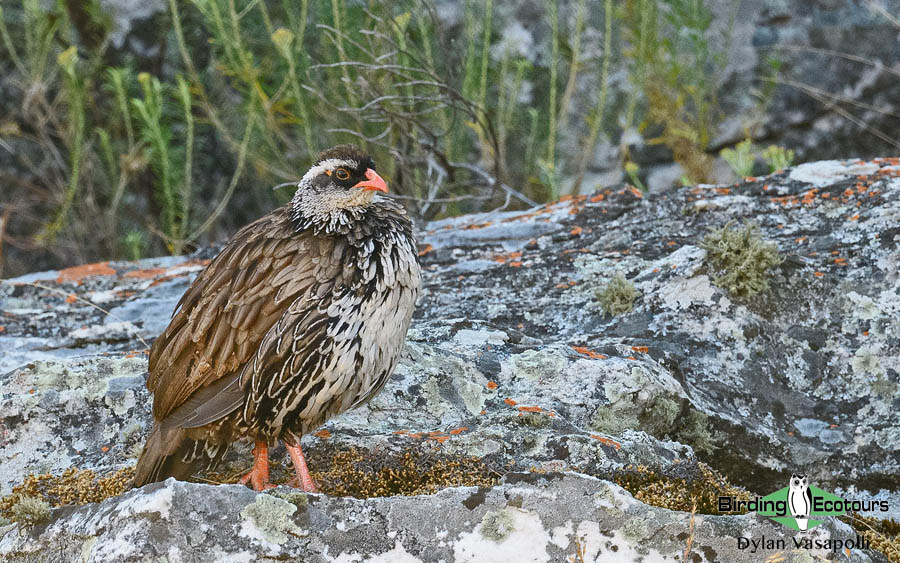
The endemic Swierstra’s Spurfowl is one of Angola’s rarest and most sought-after specials, and fortunately showed exceptionally well on our tour!
Despite this tour taking place towards the end of the worldwide Covid-19 pandemic, travel throughout the country was largely smooth, with no Covid-related issues to speak of. Logistics were also generally smooth, though as to be expected with travel in any rural third-world country, occasional delays and long transfers are inevitable with bad and poorly maintained roads the core problems. Fuel shortages experienced in the northern half of the country were managed as best as possible, and fortunately didn’t impede any of the birding, and the weather was generally very pleasant, again not impeding any birding.
This tour was focused on getting the various endemics, near-endemics and other highly prized birds that can be found within the country, and priority was given to these species – with the tour group not focusing on the more common and widespread species that can be found elsewhere. As such, this tour was not aimed at getting a high trip total, with various water-birding stops often overlooked, and many of the more widespread and common species missed on the tour.
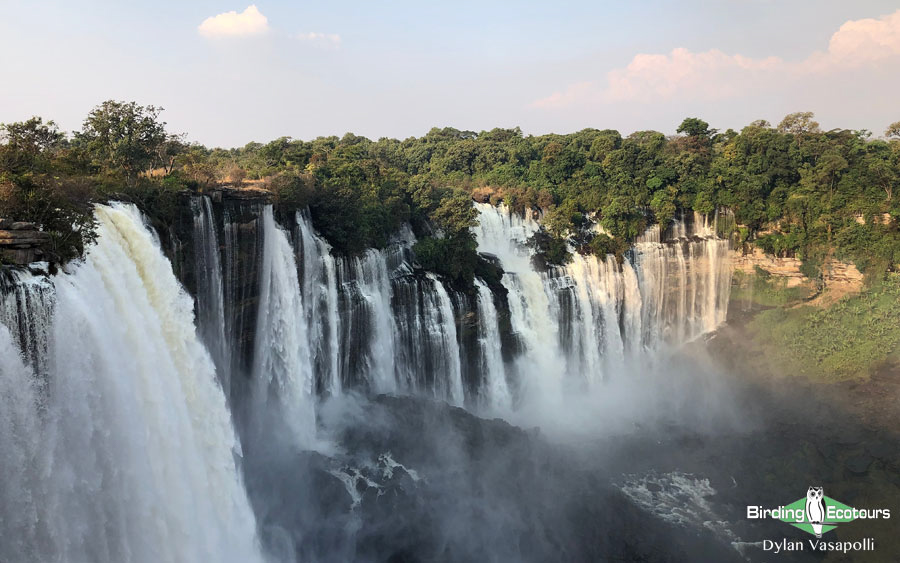
The majestic Kalandula Falls are one of Angola’s premier landmarks.
We started the trip in Luanda, the giant Angolan capital city, before we made our way to the Muxima woodlands for our first dose of endemic birding. This venue yielded the shy Grey-striped Spurfowl and the rare Gabela Helmetshrike, along with White-fronted Wattle-eye and Monteiro’s Bushshrikes as the other endemics seen. Journeying up to the northern scarp forests followed. Here we found the rare Braun’s Bushshrike, along with a host of equatorial species such as Black Bee-eater and Great Blue Turaco, alongside other specials such as Yellow-throated Nicator, Falkenstein’s Greenbul, and the local Black-collared Bulbul. The Kalandula region followed, delivering unexpected birds such as Angolan Lark and Marsh Widowbird, along with expected specialties like the mega White-headed Robin-Chat through to the endemic Red-crested Turaco – Angola’s national bird. Other exciting birds seen here included White-spotted Flufftail, Anchieta’s Barbet, Ross’s Turaco, African Broadbill, Red-throated Cliff Swallow, Bates’s and Bannerman’s Sunbirds and Sharp-tailed Starling. Naturally, we ensured we visited the spectacular Kalandula Falls as well. The birdy Tombingo Forests produced the likes of Red-fronted Parrot, Bristle-nosed Barbet and Red-rumped Tinkerbird amongst others, before an opportunistic stop en-route to Conda, yielded an incredible Egyptian Plover!
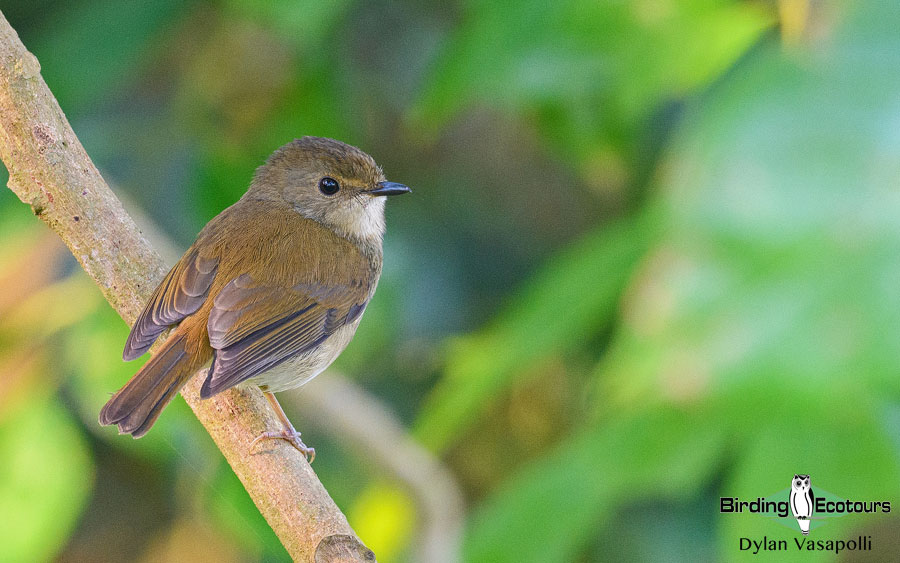
Gabela Akalat is one of several localized Angolan endemics restricted to the central regions of the escarpment. We enjoyed sublime views of this normally shy species!
Conda, and the nearby Kumbira Forest followed, where we tracked down yet more endemics and specialties in the sadly quickly-disappeared forest. Top birds here went to Gabela Bushshrike, Gabela Akalat, Pulitzer’s Longbill and Red-crested Turaco, while other exciting species included Yellow-bellied Wattle-eye and the local endemic race of Naked-faced Barbet (known as Pale-throated Barbet). The Mount Moco region was next up, and produced some excellent birds. The montane areas held the likes of Swierstra’s Spurfowl, Angolan Waxbill, Ludwig’s Double-collared Sunbird and the unique race of Rock-loving Cisticola (known as Huambo Cisticola) amongst others. The miombo woodlands and floodplains on the lower slopes gave up a variety of birds from White-breasted Cuckooshrike, Red-capped Crombec, Yellow-bellied Hyliota to Black-and-rufous Swallow and Bocage’s Sunbird. The Benguela area produced the first of the more typical Namibia specials, with the likes of Hartlaub’s Spurfowl and Rockrunner showing along with many others, before we moved onto the Lubango area. The Tundavala Mountains were excellent, producing our final endemic, Angolan Slaty Flycatcher, along with other species such as Angolan Cave Chat, Bocage’s Akalat, and repeat views of the rare Swierstra’s Spurfowl. Our final day was spent birding a transect of habitats towards the coast of Namibe, and yielded more exciting birds including Rüppell’s Korhaan, Benguela Long-billed Lark, Monteiro’s Hornbill and a great many others. The trip ended in the southern city of Lubango.
The trip bird list just exceeded 400 species in total, with slightly fewer than this being seen as there were a handful of “heard only” species. The mammal count for the trip was low as expected. The full trip lists can be found at the end of this report.
Detailed Report
Day 1, 15th June. Arrival in Luanda, and birding the Kwanza River
Today was the arrival day, with the morning spent collecting guests as they arrived in Luanda and transferring to the Kwanza Lodge, scenically set on the banks of the Kwanza River south of the city. We were able to take a late afternoon walk around the area and managed to familiarize ourselves with some of the more widespread birds. Open areas held two exciting birds – both near-endemic – Red-backed Mousebird and Bubbling Cisticola, along with others such as Little Bee-eater and Blue Waxbill. Blue-breasted Kingfisher played hide and seek with us, calling from deep within the mangroves but remaining unseen, while various waterbirds moved about including Cape Cormorant and African Fish Eagle. Flocks of feral, and noisy, Rosy-faced Lovebird settled down for the evening and brought our first day to a close.
Day 2, 16th June. Birding the Kwanza and Muxima woodlands
We began our day off with a morning walk around the area. Our main target was the tricky Mangrove Sunbird, and while it took a bit of effort to track down, we enjoyed some good and close up views of this bird, as it busily moved about. Various waterbirds were once again quite active, and we added the likes of African Sacred Ibis, White-breasted Cormorant and Great Egret, amongst others. A flock of Mottled Swifts moved about overhead, while both Striped and Woodland Kingfishers showed well virtually side-by-side. Blue-breasted Kingfisher refused to show itself once more. Various other birds such as Palm-nut Vulture, Cardinal Woodpecker, Swamp Boubou, Rufous-vented Paradise Flycatcher and attractive Green-headed and Purple-banded Sunbirds were all evident. Following a good breakfast, we gathered our things and set off to the Muxima woodlands, set in the southern corner of the Kissama National Park.
A number of Angola’s endemics can be sought in these dry woodlands, and indeed it is actually the best locality to find some of these birds, and is a vital stop for any birding tour. Our late morning arrival meant we still had some time to enjoy the birding before it started tailing off, and indeed, we had barely begun our session when we ran into a bird party. Near-endemic Pale-olive Greenbuls snuck around the thickets, and showed well after some work, while a noisy group of White-crested Helmetshrikes floated by. Both Black-headed and African Golden Orioles were present, as was a pair of vocal Black Scimitarbills. Things started hotting up once more whilst enjoying another of the near-endemics, Hartert’s Camaroptera, when a flock of the rare and localized Gabela Helmetshrikes popped into view – our first true country endemic! We spent a short while with them, as they flopped around in their comical way, before a White-fronted Wattle-eye began to call – another endemic. Frustratingly, the bird only gave us brief views and left us wanting a bit more. Several of the peculiar Böhm’s Spinetail were also seen flying overhead before we had a break for lunch.
Our afternoon was a bit more leisurely, spent birding around the Kwanza River, well downstream of where we were this morning, however. Here we added a few more waterbirds, with the likes of White-faced Whistling Duck, African Jacana, Squacco Heron and Little Egret featuring. The very high level of the river meant there were no sandbars present, and one of our core targets here, Egyptian Plover, was not around. Nevertheless, we enjoyed a very productive first full day of birding.
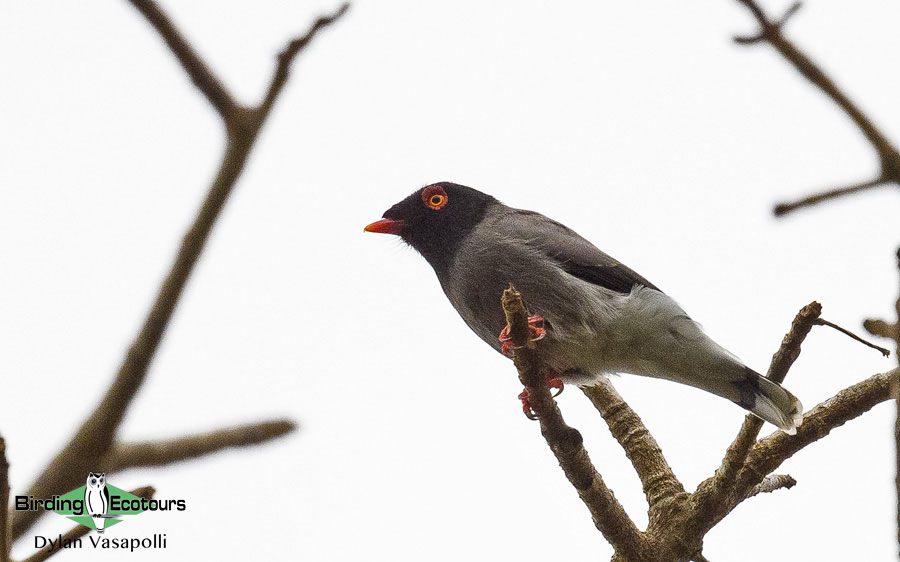
Gabela Helmetshrike was one of our early tour highlights in the dry woodlands around Muxima.
Day 3, 17th June. Birding the Muxima woodlands
With a few key targets still outstanding, we had an early start as we set off to bird the dry Muxima woodlands. Cool, overcast conditions kept bird activity high for the morning, and we did enjoy an excellent morning out. We got off to a flying start when our first stop produced the goods, delivering the shy endemic Grey-striped Spurfowl, which showed well, albeit briefly crossing the road. Thicker vegetation produced a lovely African Barred Owlet, with a mass-entourage of birds mobbing it including Green Wood Hoopoe, Brown-hooded Kingfisher, Black-backed Puffback, African Paradise Flycatcher, Scarlet-chested Sunbird, and best of all, another flock of the scarce Gabela Helmetshrikes! Forest Scrub Robin played hide and seek with us, with only some in the group managing views of this songster, before a Monteiro’s Bushshrike started calling – our last remaining endemic possible here. We set off in search of this bird, and after some careful positioning and some patience, we were rewarded with our first, albeit distant views. Bit by bit, our views got better and better, and we ended up enjoying excellent views of this stunning bird! Further birding yielded far better looks at White-fronted Wattle-eye than what we had managed the previous day – leaving us all feeling much better, along with netting other species such as Angolan Batis, Cardinal Woodpecker, Rufous-tailed Palm Thrush and Grey Waxbill. As the day began warming up, raptors became more obvious with the likes of African Harrier-Hawk, Brown Snake Eagle, Western Banded Snake Eagle, African Goshawk and Little Sparrowhawk all featuring. We also enjoyed views of Mottled Spinetail in between numerous Böhm’s Spinetails. Following a lunch break, we returned to our lodge where we had the afternoon at leisure, owing to our successful morning out.
Day 4, 18th June. Muxima to Uige
We had a long transfer today, making our way up to Uige, in the north of the country, where we would spend three nights, and have two full days to explore the mosaic of grasslands and equatorial scarp forests. The bulk of the day was spent driving, with little of interest seen along the way, but we did manage to get some birding in at the Damengola Forest in the late afternoon. The birding was extremely slow, however, and we struggled to eke out any birds, although picking up the likes of Naked-faced Barbet, Little Green Woodpecker, Banded Prinia and a lively flock of Rufous-crowned Eremomelas. While various other birds were heard calling, none cooperated. We called it time, and checked into our hotel in Uige, before settling down for the evening.
Day 5, 19th June. Birding the Damengola Forest
The main reason for venturing to this part of the country is to find the incredibly localized and rare endemic Braun’s Bushshrike. This area also hosts a range of more equatorial West African species that creep into this far northern bit of Angola. Overcast conditions with some mist and light drizzle greeted us on our arrival into the forest, which was alive with bird song. In no time, we had latched onto a calling Braun’s Bushshrike, and before we knew it, we were enjoying sublime views of this bird as it gave out its deep ‘croaking’ call from right in front of us! We really could not have asked for better views of this scarce bird. We then started turning our attention to some of the many other birds present in the area. Guinea Turacos bounded from tree to tree, while both Piping and African Pied Hornbills moved to and from their feeding sites in the area. More forested area yielded the likes of Pink-footed Puffback, Black Cuckooshrike, African Blue Flycatcher, Green Crombec, Dusky-blue Flycatcher, Red-headed Malimbe and Grey-headed Nigrita, amongst others. The deep hooting of Gabon Coucal rang out from some of the forest-edge areas, and we spent a while trying to obtain views – with no less than five birds calling all around us – sadly without seeing any of them. The surrounds also produced sought-after Lowland Masked Apalis, Blue Malkoha, Chestnut Wattle-eye and the tiny Yellow-throated Nicator. Some of the more open areas gave up Brown Twinspot, though they were unseen by a few in the group. Exploring another forest patch generated a few of the stunning Black Bee-eaters – surely one of the most attractive birds anywhere – along with the giant Great Blue Turaco and some nesting Black-and-white Mannikins. Several calling Chocolate-backed Kingfishers frustratingly remained out of sight, despite our best efforts. The afternoon birding was very slow with little of interest being seen, aside from some showy Speckled Tinkerbirds, distant Blue-throated Rollers and a vocal Black-and-white Shrike-flycatcher. We returned to Uige in the late afternoon following an excellent first day in the scarp forests!
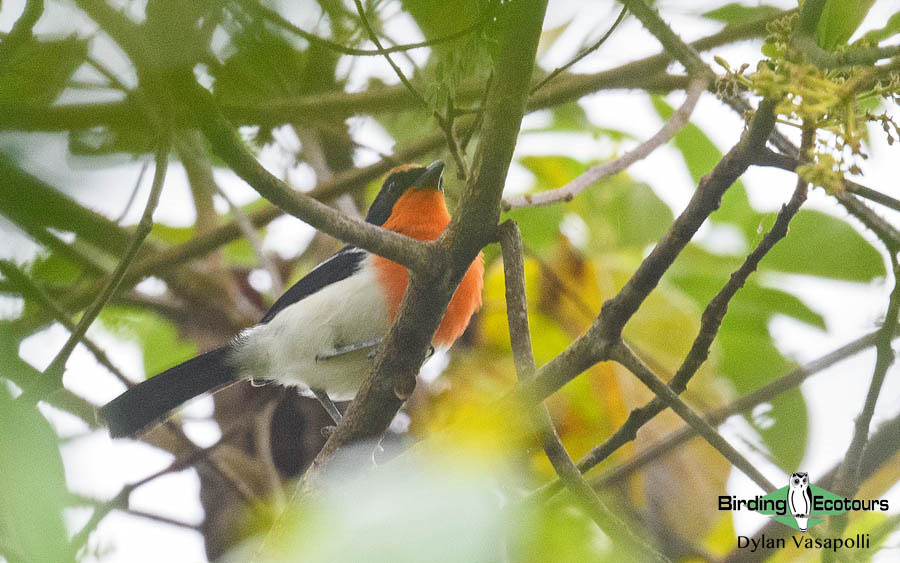
A number of Angola’s endemics are part of the bushshrike family – herewith arguably the most spectacular one – Braun’s Bushshrike – restricted to the northern scarp forests.
Day 6, 20th June. Birding the Damengola Forest
We had another day to explore the mighty scarp forests of the area trying to clean up on some of the many possible species that can be found here, with the added benefit of having already seen our main target, Braun’s Bushshrike, the previous day. We started off early in the forest, where we picked up species such as Hairy-breasted Barbet, Velvet-mantled Drongo, Blue-headed Crested Flycatcher, Falkenstein’s Greenbul, Buff-throated Apalis, Splendid Starling and Fraser’s Rufous Thrush amongst others, before venturing into the open grassy areas surrounding the forests. We spent the bulk of our morning birding these open areas, searching for our main target, the strange and localized Black-collared Bulbul. It took quite a bit of work, but we were eventually rewarded with great views of this highly sought-after bird, and in the process we added the likes of Brown-backed Scrub Robin, Compact Weaver, Black-winged Red Bishop, Orange-cheeked and Orange-breasted Waxbills and Brown Twinspot. We opted to head deeper into the forests, negotiating an ever-deteriorating road. While the birding did start to quieten down, we added the likes of Cassin’s Honeybird, Slender-billed Greenbul, Yellow-browed Camaroptera, Vieillot’s Black Weaver, Red-headed Malimbe and a plethora of sunbirds including Blue-throated Brown, Olive, Olive-bellied, Little Green, Grey-chinned and Collared Sunbirds. We did also enjoy some repeat views of various species such as Black Bee-eater, Blue-throated Roller and Braun’s Bushshrike, amongst others.
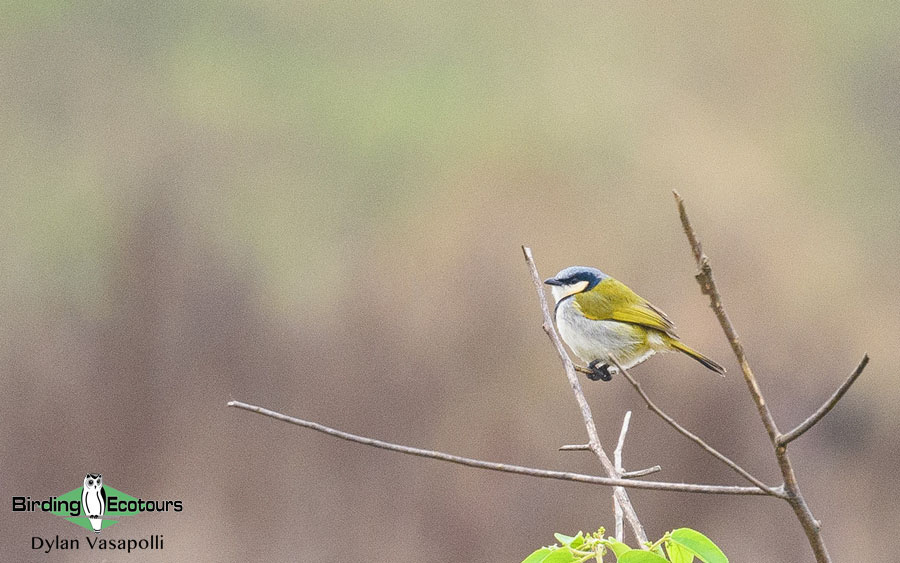
The unique Black-collared Bulbul is one of many sought-after specials occurring in Angola.
Day 7, 21st June. Uige to Kalandula, birding en-route
We left the exciting northern scarp forests behind, as we transferred southwards to the Kalandula area – home to arguably Angola’s most scenic attraction – the Kalandula Falls. Although the falls are incredible in their own right, the surrounding region plays host to a wide range of excellent birds. We made several stops along the journey with opportunistic grasslands stops producing fine Angolan Larks, Marsh Widowbirds and Fülleborn’s Longclaws, with other stops yielding Red-necked Buzzard, Retz’s Helmetshrikes, White-tailed Blue Flycatcher, Angolan Swallow, scarce Western Violet-backed Sunbird and Golden-breasted Bunting, amongst others. The road had unfortunately badly deteriorated, and took a long while to negotiate, but we eventually made our way through, and checked into our comfortable lodge on the outskirts of town, before heading off for our first dose of Kalandula birding. We arrived at the Kinjila Village, and immediately set off into the nearby swamp forests, which are home to the spectacular White-headed Robin-Chat – a species that was only fairly recently rediscovered, and is known only from a few localities! The forest was a bit quiet in the late afternoon, and while we heard White-headed Robin-Chat, we had to be content with no views – for now. A displaying African Broadbill caught our attention as well, and we enjoyed some excellent views of this sought-after bird as it displayed from an open branch right in front of us. Other species such as Cabanis’s Greenbul, Yellow-throated Leaflove and Dark-backed Weaver were added before we lost all light. We opted to stay on and try for a few nocturnal birds, and did well notching up African Scops Owl, while a brief Spotted Eagle Owl was seen on the way back – but sadly no nightjars were present.
Day 8, 22nd June. Birding Kinjila and surrounds
We had an early start once more, as we made our way to the Kinjila Village, where we met up with our excellent local guide, Joao, who would join us for the morning. We resumed where we had left off yesterday – by focusing on the mega White-headed Robin-Chat. About half of the group enjoyed good, albeit, brief views of this incredible bird early on in the day, but sadly the remainder of the group didn’t manage to get onto it. We spent a while trying for additional views, but the birds were extremely shy and refused to show. After discussing alternate plans, Joao, shepherded us off to another site, some distance away, where we would try again. The miombo along the way gave us our first views of the sought-after Sharp-tailed Starling along with Meyer’s Parrot and another Western Violet-backed Sunbird, while the grassy edges yielded a stunning pair of Brown Twinspots. Eventually, we arrived at the site, and in no time, had no less than three of the stunning White-headed Robin-Chats moving about around us, as they came to investigate these intruders. While the birds were again shy, and kept to the thickets, we enjoyed some fine views of these highly sought-after birds. A vocal White-spotted Flufftail was also seen moving through the leafy understory here.
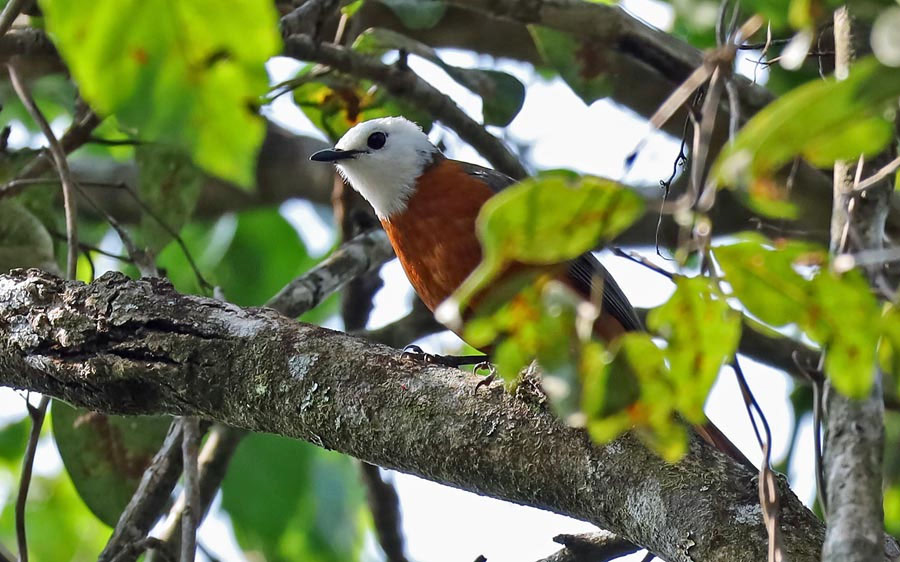
White-headed Robin-Chat is a truly mega species – its rarity, high-class status of being only recently rediscovered, and sheer appearance – all add to the appeal of this incredible bird! Photo © Richard Baxter (tour participant).
With massive smiles on our faces, we made our way back to the village and turned our attention onto some of the other birds that can be sought here. Red-crested Turaco, the national bird of Angola, was another major target, but sadly we had to be content with the birds calling around us from within the forest, with no views obtained despite much effort. Frustratingly, I was also the only person in the group to get onto the shy Grey-winged Robin-Chat. All too soon, our morning had come to a close, and we bid Joao farewell after a successful morning. Following a lunch-time break, we resumed birding the area ourselves, and stumbled into some flowering trees which were a hive of activity. Time here produced some excellent birds, with both scarce Bates’s and Bannerman’s Sunbirds showing well, while also yielding Black-throated Wattle-eye. A stop at the nearby Lucala River upstream of the falls produced a fine Greater Swamp Warbler, before we called in at the Kalandula Waterfalls to admire this immense natural attraction. While taking in this spectacular sight, we also notched up a Peregrine Falcon working the area. Following dinner, we set off to try our luck at a few night birds once more, but had to make do with a bird-less evening.
Day 9, 23rd June. Birding Kinjila and transfer to N’dalatando
While we had to transit to our next destination, at N’dalatando, the drive is a short one, and meant we had the full morning available to spend birding around Kinjila village, before setting off. We had an early start once more, starting our birding off in the miombo surrounding the village. As miombo birding can go, it was surprisingly quiet with little activity. Flocks of Sharp-tailed Starling moved about noisily overhead, as did a mixed flock of White-crested and Retz’s Helmethshrikes, with both White-breasted Cuckooshrike and Miombo Scrub Robin frustratingly remaining unseen. We also found a few of the scarce Orange-winged Pytilia feeding in the road. Following a quick bite to eat, we set off to explore another portion of the swamp forest and surrounds, and did well with a very showy pair of Ross’s Turaco (that we had only heard previously), while also notching up an unexpected pair of Red-headed Lovebirds and a Landana Firefinch. A quick jaunt into another section of miombo finally gave us Anchieta’s Barbet, though the bird didn’t hang around for very long, plus a large group of noisy Pale-billed Hornbills that put on a good show. Other species seen included Moustached Grass Warbler, Fawn-breasted Waxbill, Broad-tailed Paradise-Whydah and Cabanis’s Bunting, amongst others. With our time almost up, we opted to have one last go for Red-crested Turaco (Angola’s spectacular national bird!). After having spent much time over the last few days hearing various birds call, and not seeing any, we were elated when we obtained some views almost as soon as we stepped into their swamp forest habitat. Spending a bit more time in the area yielded more and better views – with what must have been around ten individuals bounding around in the treetops above us at one stage! Olive Long-tailed Cuckoo was heard calling from the area, but couldn’t be seen. A stop at the Lucala River on our way back finally produced the goods with a massive flock of Red-throated Cliff Swallows present.
We gathered our belongings, and following lunch, set off to N’dalatando. The bulk of the road was in good shape, and we made good time, with a quick stop along the Lucala River not producing anything of interest due to the high water levels. We checked in at our hotel in the mid-afternoon, before venturing off for the last bit of the afternoon to the nearby Tombingo Forest. We had a very birdy afternoon, with lots of birds present – enjoying the likes of colorful Klaas’s Cuckoo, noisy Honeyguide Greenbuls, drumming Yellow-crested Woodpeckers and a few of the strange Naked-faced Barbets. Eventually, after much searching, we also finally tracked down Red-rumped Tinkerbird – a species we had been looking for, while also enjoying repeat views of birds such as Fraser’s Rufous Thrush, Black-winged Oriole, Green Crombec, Ashy Flycatcher and White-breasted Nigrita. We settled in for the evening, following another successful day.
Day 10, 24th June. Birding Tombingo Forest, and transfer to Conda
Today was effectively another travel day, as we made our way further southwards, to the Conda area – home to the endemic-rich Kumbira Forest. However, we had a bit of time available in the morning, and were able to spend it at the excellent Tombingo Forest. We again had a great time in this birdy forest with the morning sky filled with numerous Piping and African Pied Hornbills along with noisy Red-fronted Parrots as they all commuted up and down. We were also eventually able to track down another of our outstanding forest birds – Bristle-nosed Barbet – as we found a large mixed flock of both this species and the similar Naked-faced Barbet moving about. The attractive Yellow-billed Barbet showed well, and was a hit with everyone, as was the incredibly colorful Purple-throated Cuckooshrike. We again had repeat views of various species such as Buff-throated Apalis, Green Hylia, Rufous-crowned Eremomela, Yellow-throated Nicator and Falkenstein’s Greenbul, while also adding the likes of Green-throated and Superb Sunbirds, amongst several other sunbird species. Eventually we had to tear ourselves away, and press onwards. Unfortunately, whilst trying to refuel in town, we learned that the area was entirely without diesel, leaving us in a bit of a pickle – but fortunately, our excellent local driver managed to secure some for us, allowing us to continue on our way following a bit of a wait. We eventually broke for our lunch along the way, and it proved to be very fortuitous, as an incredible Egyptian Plover patrolled the shoreline right in front of where we had stopped. With the high water levels in the country, we could scarcely believe our luck having given up on this bird, and enjoyed some great views of this highly prized species! The rest of the afternoon was spent in transit, as we made our way along the windy road to Conda, eventually arriving just before dark.
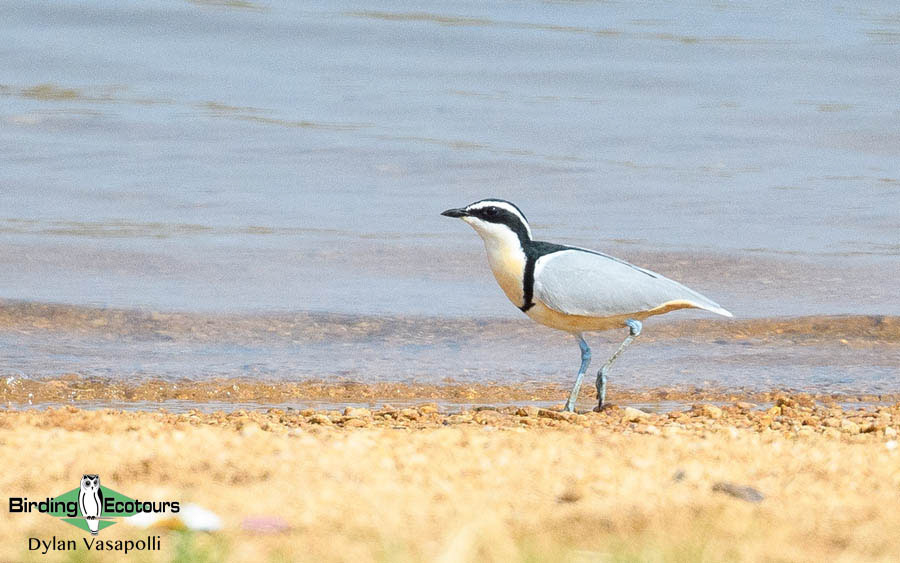
Finding an Egyptian Plover along this leg of the route was a very welcome surprise!
Day 11, 25th June. Birding Kumbira Forest
Kumbira Forest is one of the most important birding localities in Angola, hosting a number of Angolan endemics that are largely restricted to this central part of the escarpment, and not possible outside of this area. The forest, however, has been a major cause for concern with immense deforestation taking place, and this tour showed us that there were no signs of it easing up – urgent action is required.
We had given ourselves two full days in the area, which would hopefully be enough time to track down the many target species we had here. As we slowly made our way into the ‘forest’, which consists primarily of cleared and open bushy areas, with some larger trees lining the various water courses – we began working the area, stopping wherever there were bits of bird activity. We were off to a great start with early stops producing the first of our endemic targets – Gabela Akalat. This is a shy forest robin, and we were thrilled to enjoy excellent, and for an akalat, extremely prolonged views! We also got quickly acquainted with many of the more regularly-occurring birds of the area, some of which we had already seen on the tour – such as Crowned Hornbill, Yellow-rumped Tinkerbird, Little Green Woodpecker, Angolan Batis, African Blue Flycatcher, Falkenstein’s Greenbul and Buff-throated Apalis, amongst others. We also enjoyed several sightings of African Broadbill, before we heard the tell-tale calls of Gabela Bushshrike – arguably the most difficult-to-find endemic in the country (given the current status of this quickly-disappearing forest). The bird was well off in the distance, and we slowly set about making our way closer, and after a stiff uphill climb, found ourselves within arms-length of the bird. It took a nervous few moments before we all managed to get onto the bird, with only some in the group initially able to see it. As it turned out, we needn’t have worried, as we all enjoyed excellent looks at this highly sought-after species, leaving us all brimming from ear to ear! We also picked up on the local endemic subspecies of Naked-faced Barbet (known as Pale-throated Barbet – surely a split in waiting) nearby.
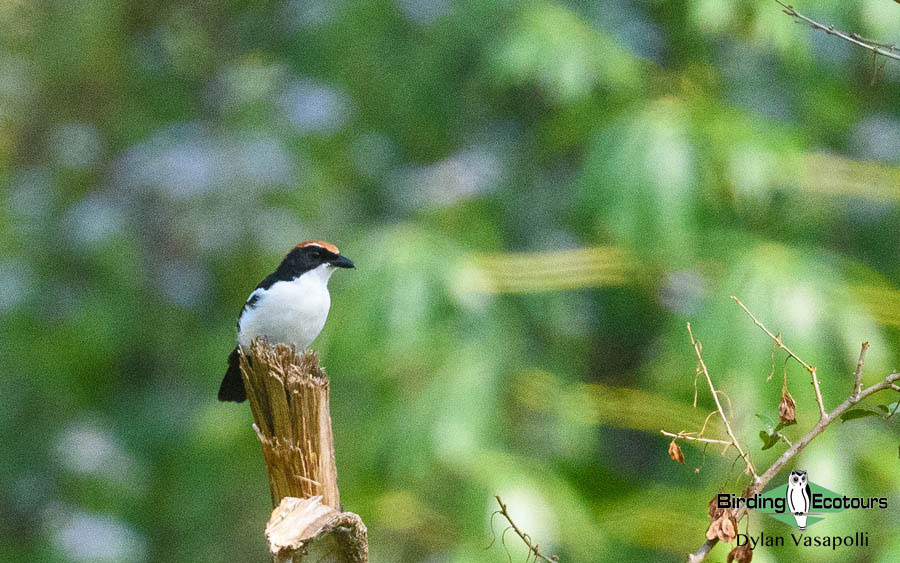
Gabela Bushshrike is easily one of the most difficult to-find Angolan endemics.
The remainder of our morning was excellent as well, with us enjoying a small feeding group of Red-crested Turacos – giving us some great views, along with the puzzling local race of Southern Hyliota (known as Forest Hyliota), Dusky Tit, Blue Malkoha and Yellow-throated Nicator. Another shy forest robin, Brown-chested Alethe, gave us extraordinary views, sitting motionless a short distance away, while a pair of colorful Yellow-bellied Wattle-eyes dazzled us with prolonged views. We had one last major target, the rare endemic, Pulitzer’s Longbill, and as if our already great day couldn’t get any better, we struck gold finding a pair of these strange birds on our way out of the forest. While they proved difficult to see well, keeping to the dark thickets and speedily hopping along, we were satisfied with our views, and called it a day with the remainder of the afternoon spent at leisure around our comfortable lodge.
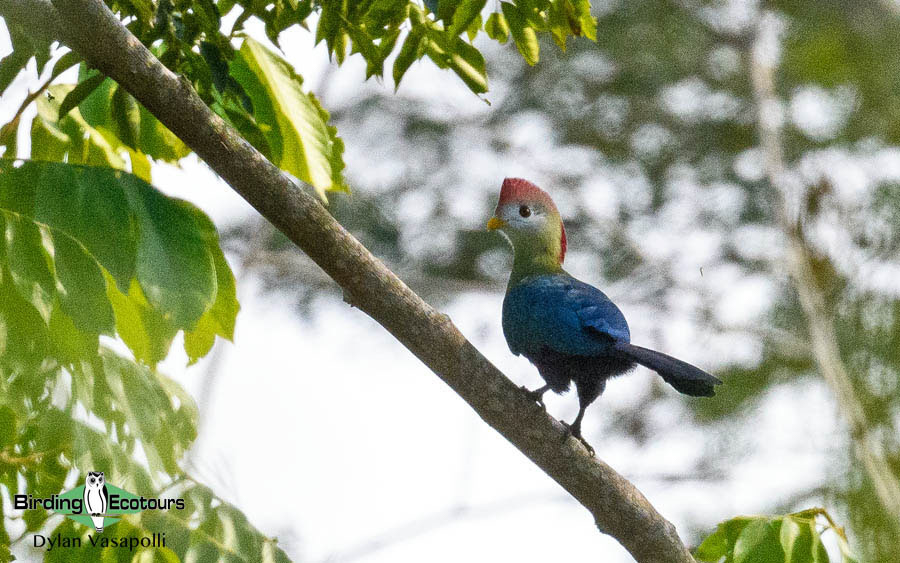
Angola’s national bird, Red-crested Turaco, is also one of the most sought-after endemics.
Day 12, 26th June. Birding Kumbira Forest
With the pressure effectively ‘off’, having bagged all our major targets, we spent the morning exploring a different part of the forest – which was sadly in even more dire straits with the deforestation. As a whole, the day was much slower than the previous day. We started off well nevertheless, with far better views of a pair of Pulitzer’s Longbills than we managed the previous day. A lovely Black-backed Barbet was another early highlight, as was a Forest Scrub Robin that played hide and seek with the group – showing extremely well to half the group, while remaining unseen by the other half. We also enjoyed repeat views of Red-crested Turaco, Yellow-bellied Wattle-eye, Falkenstein’s Greenbul and Brown Twinspot. Finding a pair of White-fronted Wattle-eyes, another of Angola’s endemic birds we had enjoyed earlier on the trip around Muxima, was a big surprise. Our afternoon was spent at leisure around the lodge.
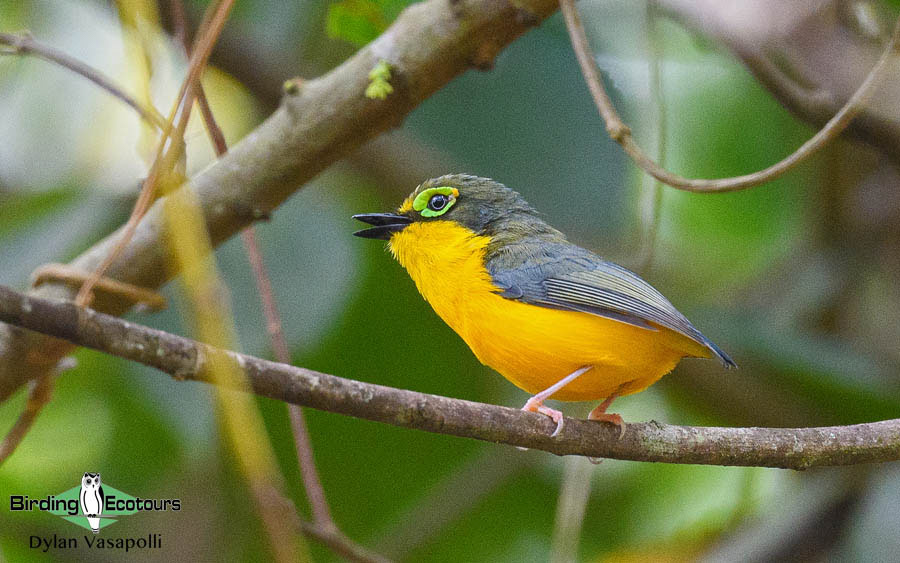
The snazzy Yellow-bellied Wattle-eye was a firm favorite amongst the group.
Day 13, 27th June. Conda to Mount Moco
An exciting few days lay ahead, as we moved away from the Kumbira Forest area towards Mount Moco – the highest mountain in Angola. We made good progress on the bad roads, with some stops on the way producing Sooty Chat and the highly sought-after Black-and-rufous Swallow, before we arrived into the greater Mount Moco area, concentrating on the more open lower slopes. Although it was warm and sunny out, we enjoyed a productive afternoon with our main highlight being a few of the highly sought-after Bocage’s Sunbirds showing well around some flowering plants. Careful watching here also produced the scarce Oustalet’s Sunbird amongst the more numerous Copper, Variable and Amethyst Sunbirds. Riverine trees produced a lovely Anchieta’s Barbet, that was sadly chased away very quickly by Black-collared Barbets, with the surrounding rank growth delivering Coppery-tailed Coucal, African Yellow Warbler, Short-winged Cisticola, Yellow Bishop and Fawn-breasted Waxbill. A pair of Fülleborn’s Longclaws showed in some of the floodplain areas, which were also a haven for swallows, with Grey-rumped, Pearl-breasted, Lesser Striped and repeat views of Black-and-rufous Swallows all showing well! We eventually had to pull ourselves away from the birding, and made the long journey to our lodge, not helped with the badly potholed road, where we arrived just before dark.
Day 14, 28th June. Birding Mount Moco IBA
One of the most anticipated days of the trip had arrived – our full day of exploring Mount Moco, with us also venturing onto the mountainous slopes in search of some of the montane specials, and the last remaining country endemics. We had an early start from our lodge, as we made the long journey to the mountain, eventually arriving at the Kanjonde village, where we arranged access to the forest on the lower slopes of the mountain. As a great change from the somewhat heart wrenching sight of the disappearing Kumbira Forest, this village has an active reforestation program where appropriate trees are planted in the area. We did not make the arduous hike up to the forest patch at the top of the mountain, but rather focused our efforts on the smaller fragmented patches on the lower slopes just above the village, and the core focal point of the reforestation project. The wind was intense during the morning, and meant we had a very quiet start to the day, with virtually no sight or sound of anything. The forest edge eventually yielded a pair of the local race of Rock-loving Cisticola, known as Huambo Cisticola which is a species in waiting and will be split off in due course, along with the first of our outstanding endemic birds – Ludwig’s Double-collared Sunbird. We also got onto some Grey Apalis and White-tailed Blue Flycatchers, before we picked up a stunning Western Tinkerbird that gave us excellent views! As we ventured further, exploring some of the more rank growth on the slopes, arguably our main target for this area, and another contender for Angola’s most difficult endemic, Swierstra’s Spurfowl, called, though remained firmly hidden in the dense undergrowth. We spent a long while working the bird, and eventually managed to get some good, albeit brief views, as the bird flushed from the undergrowth edge close to us. Not perhaps the greatest views of this scarce endemic, but we were elated to have set eyes on this difficult bird. Whilst waiting for the spurfowl, we did well notching up another endemic, Angolan Waxbill – which gave us incredibly close views, almost landing on top of us. Dusky Twinspots were not as cooperative, only giving us brief views. Other species seen included Horus Swift, Schalow’s Turaco, Olive Woodpecker, Black-throated Wattle-eye, Wailing Cisticola, African Dusky Flycatcher, Bronzy Sunbird, Dusky Indigobird and Yellow-crowned Canary.
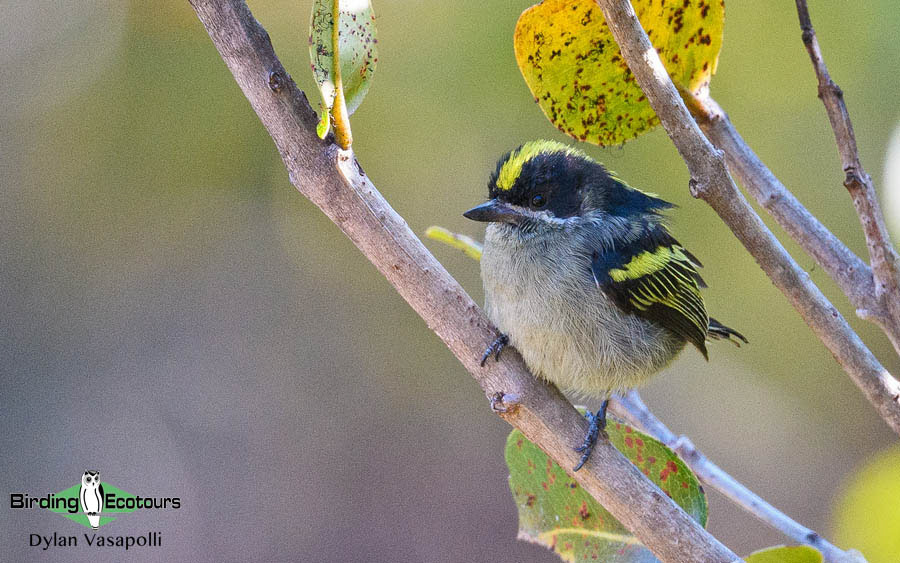
We had great looks at Western Tinkerbird on the slopes of Mount Moco.
We eventually made our way back down from the forested areas, and headed into the miombo woodlands on the lower slopes of the mountain, where we would spend the afternoon. As it often goes in miombo woodland, which is very much bird-party dependent, the birding can be slow, and we had a fairly quiet afternoon, though with considerable effort we managed to eke out a few birds. Noisy and boisterous Green-capped Eremomelas were quite common, with us finding many different families, while a male Miombo Rock Thrush showed well, as did a fine Miombo Scrub Robin. A bit of activity late in the day gave up a few specials, with a bright Yellow-bellied Hyliota popping into view, before a drab Miombo Wren Warbler and a shy Red-capped Crombec showed as well. An unexpected Black-bellied Bustard was seen on our way out. Following an excellent, but long day out in the field, we returned to our lodge, and were greeted with an excellent Western Barn Owl sitting under the eaves, before we settled in for the evening.
Day 15, 29th June. Birding Mount Moco IBA, and transfer to Benguela
We had an early start once again, this time departing the lodge with all our belongings as we ultimately transferred to the coast, at Benguela, where we would spend the night. We had effectively the full morning available to us to bird the greater Mount Moco area, and opted to explore an interesting looking area, that would hopefully produce some miombo birds and some floodplain birds. The miombo was generally quite birdy, and we did well with a few bird parties yielding a lovely White-breasted Cuckooshrike, along with numerous Miombo Scrub Robins, Wood Pipits, Western Violet-backed Sunbirds, along with Dark Chanting Goshawk, a shy Green-backed Honeybird, Greater Honeyguide, Black-crowned Tchagra, Grey Penduline Tit, Red-capped Crombec, Yellow-bellied Hyliota and Yellow-throated Bush Sparrow. Once again, we found numerous Green-capped Eremomelas, and no matter how hard we tried, we just couldn’t seem to find any of the sought-after Black-necked Eremomela. A promising looking floodplain produced Black-and-rufous Swallows, along with other widespread species, plus Chirping Cisticola, Marsh Widowbird and Quailfinch, amongst others, but little else of interest. Following our lunch break, we began the journey to the coast, but a spate of bad luck hindered our progress – with two punctures along the way, and immense roadworks through Lobito which took the better part of 1.5 hours to navigate – and ultimately meant we needed to sacrifice our wetland birding, and we arrived after dark at our lovely coastal hotel near Benguela, where a wonderful seafood dinner settled us in for the night.
Day 16, 30th June. Benguela to Lubango, birding en-route
Today is largely set aside as a travel day, as we make our way to Lubango for the final few days of the tour – though with some obligatory stops along the way. We had a slightly easier-going morning, and started our day off with a quick coastal saltworks stop that produced Lesser Flamingo, a variety of shorebirds including Black-winged Stilt, Kittlitz’s Plover, Curlew Sandpiper and Common Greenshank, along with a gull/tern roost comprised of Kelp and Grey-headed Gulls and Caspian and Sandwich Terns. We then transited inland where we focused on some mountain birding, searching for some of the more typical Namibia specials. Core amongst these is the scarce Hartlaub’s Spurfowl, which showed remarkably well shortly after we arrived in the area. We then set about on a short walk, notching up delightful White-tailed Shrikes as they bounded across the plains, along with others specials such as Rüppell’s Parrot, Bare-cheeked Babbler and best of all, a lovely Rockrunner, perched up and singing away for us. Other birds seen here included Mottled Spinetail, tiny Pearl-spotted Owlet, Red-faced Mousebird, Common Scimitarbill, Acacia Pied Barbet, Pririt Batis, Southern White-crowned Shrike, White-browed Scrub Robin and White-throated Canary. A pair of Verreaux’s Eagles and an African Hawk Eagle graced the skies before we had to call time and continue on our journey. The road was slow going in places, and the Lubango traffic meant we finally arrived at our comfortable lodge in the late afternoon, and settled in for the last three nights of the trip.
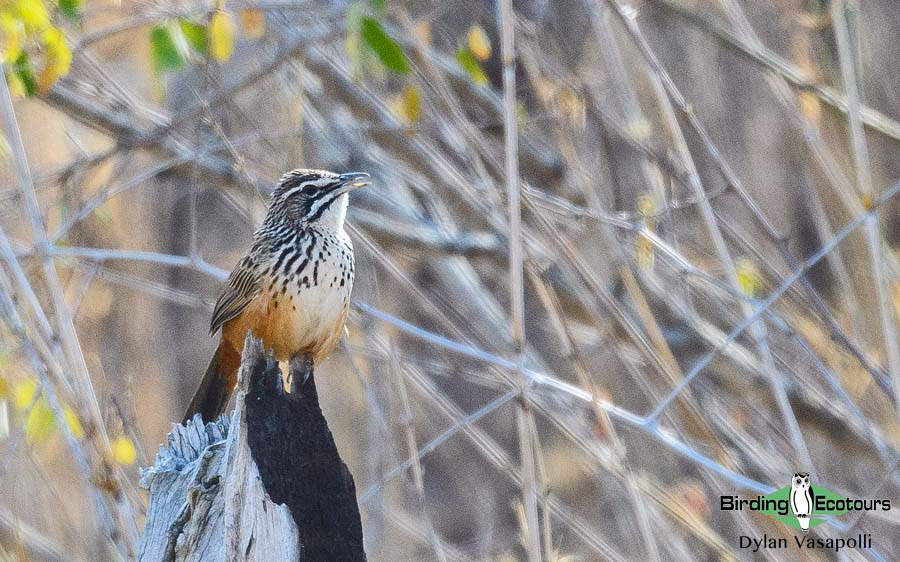
Rockrunner is traditionally seen as a ‘Namibian specials’, but occurs widely in appropriate habitat in the south of Angola.
Day 17, 1st July. Birding Tundavala
Another exciting day awaited us, as we set off for the dramatic mountains of the Tundavala area, just outside of Lubango. Our birding began quietly as we sought out our last endemic, Angolan Slaty Flycatcher along with another major target, Angolan Cave Chat. A few Ludwig’s Double-collared Sunbirds were an early highlight, as was the active White-tailed Blue Flycatcher, before a bright Orange-breasted Bushshrike popped up, but our main targets were nowhere to be found. We pressed onwards, and struck gold, finding a stunning Angolan Cave Chat sitting up in the open for all of us to admire. The bird didn’t hang around for too long, before melting back into the rocks, but we had all enjoyed great looks! A number of raptors moved about overhead, with multiple Booted Eagles, Rock Kestrels and a Lanner Falcon all showing well, before we finally got onto our last endemic, an Angolan Slaty Flycatcher. The bird didn’t hang around long, and only some of the group managed to get onto it – so we worked the area for a little while longer. This proved to be a good move, as not long after, we could scarcely contain our excitement when we latched onto a Swierstra’s Spurfowl bounding over the rocks. With a little bit of patience, we were rewarded with sublime views of this difficult endemic, as the bird came out fully into the open and put on quite the show for us! We eventually had to pull ourselves away from this incredible sighting, as the Angolan Slaty Flycatcher had returned, and this time perched up allowing everyone to get great looks at our final Angolan endemic. We all breathed a heavy sigh of relief, and marveled at the extraordinary morning we’d had so far already! A quick coffee and biscuit break allowed us to reflect on the incredible sightings we’d had this morning, before we resumed exploring further areas. Short-toed Rock Thrush and Rockrunner showed well to us, before we focused on trying to get Bocage’s Akalat, which we had missed earlier on the trip. It took a bit of work, but we were well rewarded, with good looks at this stunning bird, along with repeat views of both Angolan Cave Chat and Angolan Slaty Flycatcher in the process as well.
We took a break over the midday period, returning to our lodge, before resuming later in the afternoon, this time exploring the lower slopes of the Tundavala area. We had a good afternoon, with the scrubby vegetation on the lower slopes yielding Violet-eared Waxbill, the local race of Jameson’s Firefinch (known as Ansorge’s Firefinch), Tinkling Cisticola, a calling Bokmakierie and a lone Salvadori’s Eremomela – another of the target birds we missed earlier on the trip. Some riverine vegetation gave up a pair of Lesser Swamp Warblers and Holub’s Golden Weavers, before rounding out the day with a scenic view of this stunning area. Following dinner, we ventured back up to the top, to try for some night birds, with a vocal Freckled Nightjar calling in the distance about the best we could manage. Regardless, we couldn’t have asked for a better day exploring the scenic Tundavala area.
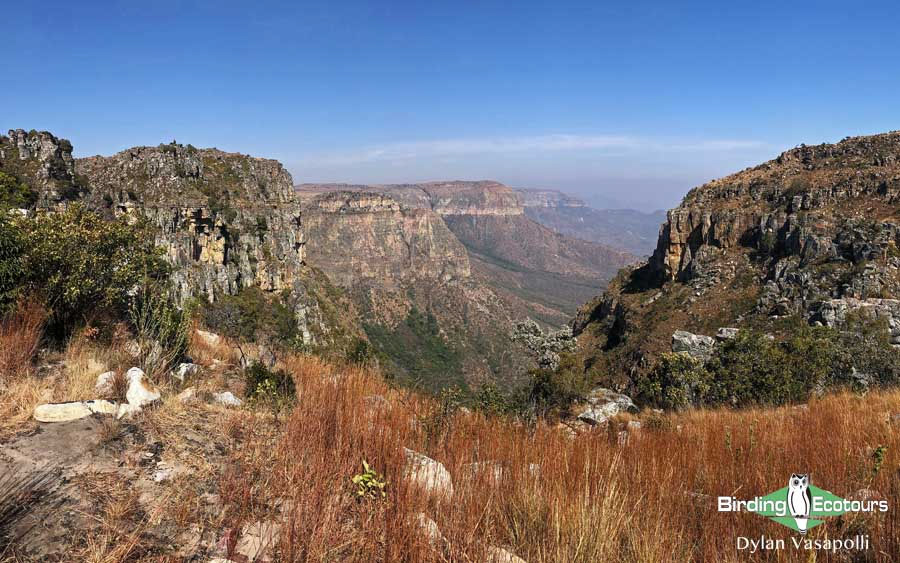
The spectacularly scenic Tundavala area produced some excellent birding!
Day 18, 2nd July. Birding day trip to Namibe
This was our last full day birding of the trip, and we set off early bound for the Namibe region. This is a particularly interesting route, as the habitat becomes drier and drier the closer to the coast you get – with all the regions hosting a different set of birds. Once we had descended the scenic Leba Pass, we began our birding off by searching some of the riverine scrub and surrounds in the initial stages of the route for the tricky Cinderella Waxbill. Try as we might, we just couldn’t find any individuals, and would indeed miss this bird today. Aside from the waxbill, we enjoyed some excellent birding, adding a few more of the more typical Namibian specials such as Monteiro’s and Damara Red-billed Hornbills, Rosy-faced Lovebird (proper wild birds here, compared to the feral birds around the Kwanza River), and the local race of Meves’s Starling, while getting repeat views of other specials such as White-tailed Shrike and Rüppell’s Parrot. Other birds that kept us entertained included Red-necked Spurfowl, Grey Go-away-bird, Gabar Goshawk, Red-backed Mousebird, African Grey Hornbill, Swallow-tailed Bee-eater, Yellow-fronted Tinkerbird, Pririt Batis, Brown-crowned Tchagra, White-crested Helmetshrike, African Red-eyed Bulbul, Yellow-breasted Apalis, Yellow-billed Oxpecker, White-browed Sparrow-Weaver and White-bellied Sunbird. Our next stop was much closer to the coast, where we settled into the very dry and sparse Namib Desert plains. Following our lunch break, we set off, tracking down cute Spike-heeled Larks and delicate Tractrac Chats, along with finding other species such as Mountain Wheatear and the local race of pale Karoo Chats. Rüppell’s Korhaan took some work to track down, but after hearing several croaking away, we finally got some distant views, while several Benguela Long-billed Larks put on a great display for us. We also picked up the likes of Pale Chanting Goshawk, Pale-winged Starling and Chat Flycatcher as we worked the area.
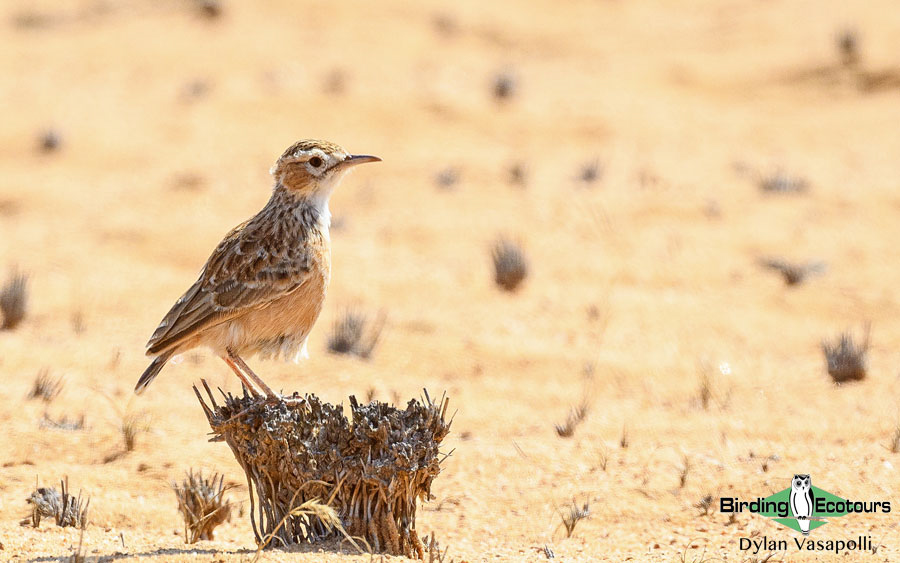
Spike-heeled Lark is one of several specials of the dry Namib Desert plains.
Our final birding stop of the day was in very dry thornveld habitat, where we had an incredibly birdy afternoon. A plethora of Scarlet-chested, Dusky and White-bellied Sunbirds were never far away, while tiny Pririt Batises bounded away in the bushes and delicate Kalahari Scrub Robins perched atop the bushes. The stunningly bright Crimson-breasted Shrike showed well, as did a confiding pair of Brubrus, while some careful searching yielded Barred Wren-Warbler and Yellow-bellied Eremomela. A number of other species we had seen earlier in the day were present as well, before we called it time, and made our way back to Lubango, pausing at the top of the Leba Pass to take in the incredibly scenic views of this area. This proved fruitful as it also yielded a surprise Carp’s Tit. We rounded off our final dinner reminiscing about the trip, and working through our main trip highlights.
Day 19, 3rd July. Departure from Lubango
With afternoon flight departures, the morning was spent at leisure around our lodge, with no formal plans. Following our final lunch together, we departed for the airport, where the tour came to a close.
I would like to thank all the participants who joined this set departure tour, for making it a good success. Likewise, thanks must also go to our excellent ground operators, all of whom made this the good success it was, with all of the country’s endemics, and almost all of the country’s main specials and near-endemics being found!
Without further ado, here are the tour favorites, as voted for by the group:
- Swierstra’s Spurfowl
- White-headed Robin-Chat
- Gabela Bushshrike
- Black-collared Bulbul
- Egyptian Plover
Honorable mentions go out to the likes of:
- Gabela Helmetshrike
- Bates’s Sunbird
- Yellow-bellied Wattle-eye
- Angola Cave Chat
- White-spotted Flufftail
- Schalow’s Turaco
- Monteiro’s Bushshrike
- Western Tinkerbird
- Landana Firefinch
- Purple-banded Sunbird
- Green-capped Eremomela
Bird List – Following IOC 12.1
Birds ‘heard only’ are marked with (H) after the common name, birds seen only by the guide are marked with a (G) after the common name, all other species were seen.
The following notation after species names is used to show conservation status following the IUCN Red List:
CR = Critically Endangered, EN = Endangered, VU = Vulnerable, NT = Near Threatened.
Angolan endemics are bolded.
| Common name | Scientific name |
| Ducks, Geese, Swans (Anatidae) | |
| White-faced Whistling Duck | Dendrocygna viduata |
| Guineafowl (Numididae) | |
| Helmeted Guineafowl | Numida meleagris |
| Pheasants & Allies (Phasianidae) | |
| Crested Francolin (H) | Ortygornis sephaena |
| Hartlaub’s Spurfowl | Pternistis hartlaubi |
| Swierstra’s Spurfowl – EN | Pternistis swierstrai |
| Grey-striped Spurfowl | Pternistis griseostriatus |
| Red-necked Spurfowl | Pternistis afer |
| Nightjars (Caprimulgidae) | |
| Freckled Nightjar (H) | Caprimulgus tristigma |
| Swifts (Apodidae) | |
| Mottled Spinetail | Telacanthura ussheri |
| Böhm’s Spinetail | Neafrapus boehmi |
| African Palm Swift | Cypsiurus parvus |
| Mottled Swift | Tachymarptis aequatorialis |
| Bradfield’s Swift (G) | Apus bradfieldi |
| Little Swift | Apus affinis |
| Horus Swift | Apus horus |
| Turacos (Musophagidae) | |
| Great Blue Turaco | Corythaeola cristata |
| Grey Go-away-bird | Crinifer concolor |
| Ross’s Turaco | Tauraco rossae |
| Red-crested Turaco | Tauraco erythrolophus |
| Guinea Turaco | Tauraco persa |
| Schalow’s Turaco | Tauraco schalowi |
| Bustards (Otididae) | |
| Rüppell’s Korhaan | Eupodotis rueppelii |
| Black-bellied Bustard | Lissotis melanogaster |
| Cuckoos (Cuculidae) | |
| Gabon Coucal (H) | Centropus anselli |
| Senegal Coucal | Centropus senegalensis |
| Coppery-tailed Coucal | Centropus cupreicaudus |
| White-browed Coucal | Centropus superciliosus |
| Blue Malkoha | Ceuthmochares aereus |
| Levaillant’s Cuckoo | Clamator levaillantii |
| Klaas’s Cuckoo | Chrysococcyx klaas |
| Olive Long-tailed Cuckoo (H) | Cercococcyx olivinus |
| Pigeons, Doves (Columbidae) | |
| Rock Dove | Columba livia |
| Red-eyed Dove | Streptopelia semitorquata |
| Ring-necked Dove | Streptopelia capicola |
| Laughing Dove | Spilopelia senegalensis |
| Emerald-spotted Wood Dove | Turtur chalcospilos |
| Blue-spotted Wood Dove | Turtur afer |
| Namaqua Dove | Oena capensis |
| Tambourine Dove | Turtur tympanistria |
| African Green Pigeon | Treron calvus |
| Flufftails (Sarothruridae) | |
| White-spotted Flufftail | Sarothrura pulchra |
| Red-chested Flufftail (H) | Sarothrura rufa |
| Grebes (Podicipedidae) | |
| Little Grebe | Tachybaptus ruficollis |
| Flamingos (Phoenicopteridae) | |
| Greater Flamingo | Phoenicopterus roseus |
| Lesser Flamingo | Phoeniconaias minor |
| Stone-curlews, Thick-knees (Burhinidae) | |
| Water Thick-knee (H) | Burhinus vermiculatus |
| Stilts, Avocets (Recurvirostridae) | |
| Black-winged Stilt | Himantopus himantopus |
| Plovers (Charadriidae) | |
| African Wattled Lapwing | Vanellus senegallus |
| Kittlitz’s Plover | Charadrius pecuarius |
| Egyptian Plover (Pluvianidae) | |
| Egyptian Plover | Pluvianus aegyptius |
| Sandpipers, Snipes (Scolopacidae) | |
| Curlew Sandpiper | Calidris ferruginea |
| Common Greenshank | Tringa nebularia |
| Jacanas (Jacanidae) | |
| African Jacana | Actophilornis africanus |
| Gulls, Terns, Skimmers (Laridae) | |
| Grey-headed Gull (G) | Chroicocephalus cirrocephalus |
| Kelp Gull | Larus dominicanus |
| Caspian Tern | Hydroprogne caspia |
| Sandwich Tern | Thalasseus sandvicensis |
| Anhingas, Darters (Anhingidae) | |
| African Darter | Anhinga rufa |
| Cormorants, Shags (Phalacrocoracidae) | |
| Reed Cormorant | Microcarbo africanus |
| Cape Cormorant – EN | Phalacrocorax capensis |
| White-breasted Cormorant | Phalacrocorax lucidus |
| Ibises, Spoonbills (Threskiornithidae) | |
| African Sacred Ibis | Threskiornis aethiopicus |
| Herons, Bitterns (Ardeidae) | |
| Striated Heron | Butorides striata |
| Squacco Heron | Ardeola ralloides |
| Western Cattle Egret | Bubulcus ibis |
| Grey Heron | Ardea cinerea |
| Black-headed Heron | Ardea melanocephala |
| Great Egret | Ardea alba |
| Little Egret | Egretta garzetta |
| Kites, Hawks, Eagles (Accipitridae) | |
| Black-winged Kite | Elanus caeruleus |
| African Harrier-Hawk | Polyboroides typus |
| Palm-nut Vulture | Gypohierax angolensis |
| Black-chested Snake Eagle | Circaetus pectoralis |
| Brown Snake Eagle | Circaetus cinereus |
| Western Banded Snake Eagle | Circaetus cinerascens |
| Bateleur – EN | Terathopius ecaudatus |
| Crowned Eagle (H) | Stephanoaetus coronatus |
| Long-crested Eagle | Lophaetus occipitalis |
| Booted Eagle | Hieraaetus pennatus |
| Verreaux’s Eagle | Aquila verreauxii |
| African Hawk-Eagle | Aquila spilogaster |
| Lizard Buzzard | Kaupifalco monogrammicus |
| Gabar Goshawk | Micronisus gabar |
| Dark Chanting Goshawk | Melierax metabates |
| Pale Chanting Goshawk | Melierax canorus |
| African Goshawk | Accipiter tachiro |
| Little Sparrowhawk | Accipiter minullus |
| African Marsh Harrier | Circus ranivorus |
| Yellow-billed Kite | Milvus aegyptius |
| African Fish Eagle | Haliaeetus vocifer |
| Red-necked Buzzard | Buteo auguralis |
| Barn Owls (Tytonidae) | |
| Western Barn Owl | Tyto alba |
| Owls (Strigidae) | |
| Pearl-spotted Owlet | Glaucidium perlatum |
| African Barred Owlet | Glaucidium capense |
| African Scops Owl | Otus senegalensis |
| Spotted Eagle-Owl | Bubo africanus |
| Mousebirds (Coliidae) | |
| Speckled Mousebird | Colius striatus |
| Red-backed Mousebird | Colius castanotus |
| Red-faced Mousebird | Urocolius indicus |
| Hoopoes (Upupidae) | |
| African Hoopoe | Upupa africana |
| Wood Hoopoes (Phoeniculidae) | |
| Green Wood Hoopoe | Phoeniculus purpureus |
| Black Scimitarbill | Rhinopomastus aterrimus |
| Common Scimitarbill | Rhinopomastus cyanomelas |
| Hornbills (Bucerotidae) | |
| Damara Red-billed Hornbill | Tockus damarensis |
| Monteiro’s Hornbill | Tockus monteiri |
| Southern Yellow-billed Hornbill | Tockus leucomelas |
| Crowned Hornbill | Lophoceros alboterminatus |
| African Pied Hornbill | Lophoceros fasciatus |
| African Grey Hornbill | Lophoceros nasutus |
| Pale-billed Hornbill | Lophoceros pallidirostris |
| Piping Hornbill | Bycanistes fistulator |
| Rollers (Coraciidae) | |
| Lilac-breasted Roller | Coracias caudatus |
| Blue-throated Roller | Eurystomus gularis |
| Broad-billed Roller (G) | Eurystomus glaucurus |
| Kingfishers (Alcedinidae) | |
| Chocolate-backed Kingfisher (H) | Halcyon badia |
| Grey-headed Kingfisher | Halcyon leucocephala |
| Brown-hooded Kingfisher | Halcyon albiventris |
| Striped Kingfisher | Halcyon chelicuti |
| Blue-breasted Kingfisher (H) | Halcyon malimbica |
| Woodland Kingfisher | Halcyon senegalensis |
| African Pygmy Kingfisher (G) | Ispidina picta |
| Pied Kingfisher | Ceryle rudis |
| Bee-eaters (Meropidae) | |
| Black Bee-eater | Merops gularis |
| Swallow-tailed Bee-eater | Merops hirundineus |
| Little Bee-eater | Merops pusillus |
| Olive Bee-eater | Merops superciliosus |
| African Barbets (Lybiidae) | |
| Bristle-nosed Barbet | Gymnobucco peli |
| Naked-faced Barbet | Gymnobucco calvus |
| Anchieta’s Barbet | Stactolaema anchietae |
| Speckled Tinkerbird | Pogoniulus scolopaceus |
| Western Tinkerbird | Pogoniulus coryphaea |
| Red-rumped Tinkerbird | Pogoniulus atroflavus |
| Yellow-throated Tinkerbird (H) | Pogoniulus subsulphureus |
| Yellow-rumped Tinkerbird | Pogoniulus bilineatus |
| Yellow-fronted Tinkerbird | Pogoniulus chrysoconus |
| Hairy-breasted Barbet | Tricholaema hirsuta |
| Acacia Pied Barbet | Tricholaema leucomelas |
| Black-collared Barbet | Lybius torquatus |
| Black-backed Barbet | Lybius minor |
| Yellow-billed Barbet | Trachyphonus purpuratus |
| Honeyguides (Indicatoridae) | |
| Cassin’s Honeybird | Prodotiscus insignis |
| Green-backed Honeybird | Prodotiscus zambesiae |
| Brown-backed Honeybird | Prodotiscus regulus |
| Greater Honeyguide | Indicator indicator |
| Woodpeckers (Picidae) | |
| Bennett’s Woodpecker (H) | Campethera bennettii |
| Little Green Woodpecker | Campethera maculosa |
| Bearded Woodpecker | Chloropicus namaquus |
| Yellow-crested Woodpecker | Chloropicus xantholophus |
| Cardinal Woodpecker | Dendropicos fuscescens |
| Olive Woodpecker | Dendropicos griseocephalus |
| Caracaras, Falcons (Falconidae) | |
| Rock Kestrel | Falco rupicolus |
| Lanner Falcon | Falco biarmicus |
| Peregrine Falcon | Falco peregrinus |
| African & New World Parrots (Psittacidae) | |
| Red-fronted Parrot | Poicephalus gulielmi |
| Meyer’s Parrot | Poicephalus meyeri |
| Rüppell’s Parrot | Poicephalus rueppellii |
| Old World Parrots (Psittaculidae) | |
| Red-headed Lovebird | Agapornis pullarius |
| Rosy-faced Lovebird | Agapornis roseicollis |
| African & Green Broadbills (Calyptomenidae) | |
| African Broadbill | Smithornis capensis |
| Wattle-eyes, Batises (Platysteiridae) | |
| Chinspot Batis | Batis molitor |
| Pririt Batis | Batis pririt |
| Angolan Batis | Batis minulla |
| White-tailed Shrike | Lanioturdus torquatus |
| Chestnut Wattle-eye | Platysteira castanea |
| Black-throated Wattle-eye | Platysteira peltata |
| White-fronted Wattle-eye | Platysteira albifrons |
| Yellow-bellied Wattle-eye | Platysteira concreta |
| Bushshrikes (Malaconotidae) | |
| Monteiro’s Bushshrike | Malaconotus monteiri |
| Bocage’s Bushshrike (H) | Chlorophoneus bocagei |
| Orange-breasted Bushshrike | Chlorophoneus sulfureopectus |
| Gorgeous Bushshrike (H) | Telophorus viridis |
| Bokmakierie (H) | Telophorus zeylonus |
| Brown-crowned Tchagra | Tchagra australis |
| Black-crowned Tchagra | Tchagra senegalus |
| Pink-footed Puffback | Dryoscopus angolensis |
| Black-backed Puffback | Dryoscopus cubla |
| Braun’s Bushshrike – EN | Laniarius brauni |
| Gabela Bushshrike – EN | Laniarius amboimensis |
| Tropical Boubou | Laniarius major |
| Swamp Boubou | Laniarius bicolor |
| Crimson-breasted Shrike | Laniarius atrococcineus |
| Brubru | Nilaus afer |
| Vangas & Allies (Vangidae) | |
| White-crested Helmetshrike | Prionops plumatus |
| Retz’s Helmetshrike | Prionops retzii |
| Gabela Helmetshrike – EN | Prionops gabela |
| Black-and-white Shrike-flycatcher | Bias musicus |
| Cuckooshrikes (Campephagidae) | |
| White-breasted Cuckooshrike | Ceblepyris pectoralis |
| Black Cuckooshrike | Campephaga flava |
| Petit’s Cuckooshrike | Campephaga petiti |
| Purple-throated Cuckooshrike | Campephaga quiscalina |
| Shrikes (Laniidae) | |
| Southern White-crowned Shrike | Eurocephalus anguitimens |
| Northern Fiscal | Lanius humeralis |
| Southern Fiscal | Lanius collaris |
| Figbirds, Orioles, Turnagra (Oriolidae) | |
| Black-headed Oriole | Oriolus larvatus |
| Black-winged Oriole | Oriolus nigripennis |
| African Golden Oriole | Oriolus auratus |
| Drongos (Dicruridae) | |
| Velvet-mantled Drongo | Dicrurus modestus |
| Fork-tailed Drongo | Dicrurus adsimilis |
| Common Square-tailed Drongo | Dicrurus ludwigii |
| Monarchs (Monarchidae) | |
| Blue-headed Crested Flycatcher | Trochocercus nitens |
| Rufous-vented Paradise Flycatcher | Terpsiphone rufocinerea |
| African Paradise Flycatcher | Terpsiphone viridis |
| Crows, Jays (Corvidae) | |
| Pied Crow | Corvus albus |
| Fairy Flycatchers (Stenostiridae) | |
| African Blue Flycatcher | Elminia longicauda |
| White-tailed Blue Flycatcher | Elminia albicauda |
| Tits, Chickadees (Paridae) | |
| Carp’s Tit | Melaniparus carpi |
| Dusky Tit | Melaniparus funereus |
| Penduline Tits (Remizidae) | |
| Grey Penduline Tit | Anthoscopus caroli |
| Nicators (Nicatoridae) | |
| Yellow-throated Nicator | Nicator vireo |
| Larks (Alaudidae) | |
| Spike-heeled Lark | Chersomanes albofasciata |
| Benguela Long-billed Lark | Certhilauda benguelensis |
| Sabota Lark | Calendulauda sabota |
| Rufous-naped Lark | Mirafra africana |
| Flappet Lark | Mirafra rufocinnamomea |
| Angolan Lark | Mirafra angolensis |
| Red-capped Lark | Calandrella cinerea |
| Bulbuls (Pycnonotidae) | |
| Slender-billed Greenbul | Stelgidillas gracilirostris |
| Black-collared Bulbul | Neolestes torquatus |
| Yellow-throated Leaflove | Atimastillas flavicollis |
| Falkenstein’s Greenbul | Chlorocichla falkensteini |
| Yellow-bellied Greenbul | Chlorocichla flaviventris |
| Honeyguide Greenbul | Baeopogon indicator |
| Little Greenbul | Eurillas virens |
| Yellow-whiskered Greenbul | Eurillas latirostris |
| Plain Greenbul (H) | Eurillas curvirostris |
| Cabanis’s Greenbul | Phyllastrephus cabanisi |
| Pale-olive Greenbul | Phyllastrephus fulviventris |
| African Red-eyed Bulbul | Pycnonotus nigricans |
| Dark-capped Bulbul | Pycnonotus tricolor |
| Swallows, Martins (Hirundinidae) | |
| Black Saw-wing | Psalidoprocne pristoptera |
| Banded Martin | Neophedina cincta |
| Grey-rumped Swallow | Pseudhirundo griseopyga |
| Rock Martin | Ptyonoprogne fuligula |
| Black-and-rufous Swallow | Hirundo nigrorufa |
| Pearl-breasted Swallow | Hirundo dimidiata |
| Wire-tailed Swallow | Hirundo smithii |
| Angolan Swallow | Hirundo angolensis |
| Mosque Swallow | Cecropis senegalensis |
| Lesser Striped Swallow | Cecropis abyssinica |
| Red-throated Cliff Swallow | Petrochelidon rufigula |
| Crombecs, African Warblers (Macrosphenidae) | |
| Moustached Grass Warbler | Melocichla mentalis |
| Rockrunner | Achaetops pycnopygius |
| Yellow Longbill (H) | Macrosphenus flavicans |
| Pulitzer’s Longbill – EN | Macrosphenus pulitzeri |
| Long-billed Crombec | Sylvietta rufescens |
| Red-capped Crombec | Sylvietta ruficapilla |
| Green Crombec | Sylvietta virens |
| Hylias (Hyliidae) | |
| Green Hylia | Hylia prasina |
| Reed Warblers & Allies (Acrocephalidae) | |
| Greater Swamp Warbler | Acrocephalus rufescens |
| Lesser Swamp Warbler | Acrocephalus gracilirostris |
| African Yellow Warbler | Iduna natalensis |
| Grassbirds & Allies (Locustellidae) | |
| Evergreen Forest Warbler (H) | Bradypterus lopezi |
| Cisticolas & Allies (Cisticolidae) | |
| Red-faced Cisticola | Cisticola erythrops |
| Chattering Cisticola (H) | Cisticola anonymus |
| Bubbling Cisticola | Cisticola bulliens |
| Rock-loving Cisticola | Cisticola emini |
| Tinkling Cisticola | Cisticola rufilatus |
| Wailing Cisticola | Cisticola lais |
| Chirping Cisticola | Cisticola pipiens |
| Croaking Cisticola | Cisticola natalensis |
| Short-winged Cisticola | Cisticola brachypterus |
| Neddicky | Cisticola fulvicapilla |
| Zitting Cisticola | Cisticola juncidis |
| Tawny-flanked Prinia | Prinia subflava |
| Black-chested Prinia | Prinia flavicans |
| Banded Prinia | Prinia bairdii |
| Yellow-breasted Apalis | Apalis flavida |
| Lowland Masked Apalis | Apalis binotata |
| Black-throated Apalis (H) | Apalis jacksoni |
| Buff-throated Apalis | Apalis rufogularis |
| Grey Apalis | Apalis cinerea |
| Grey-backed Camaroptera | Camaroptera brevicaudata |
| Hartert’s Camaroptera | Camaroptera harterti |
| Yellow-browed Camaroptera | Camaroptera superciliaris |
| Miombo Wren-Warbler | Calamonastes undosus |
| Barred Wren-Warbler | Calamonastes fasciolatus |
| Yellow-bellied Eremomela | Eremomela icteropygialis |
| Salvadori’s Eremomela | Eremomela salvadorii |
| Green-capped Eremomela | Eremomela scotops |
| Rufous-crowned Eremomela | Eremomela badiceps |
| White-eyes (Zosteropidae) | |
| Northern Yellow White-eye | Zosterops senegalensis |
| Southern Yellow White-eye | Zosterops anderssoni |
| Ground Babblers (Pellorneidae) | |
| Brown Illadopsis (H) | Illadopsis fulvescens |
| Laughingthrushes & Allies (Leiothrichidae) | |
| Bare-cheeked Babbler | Turdoides gymnogenys |
| Hyliotas (Hyliotidae) | |
| Yellow-bellied Hyliota | Hyliota flavigaster |
| Southern Hyliota | Hyliota australis |
| Starlings, Rhabdornis (Sturnidae) | |
| Cape Starling | Lamprotornis nitens |
| Splendid Starling | Lamprotornis splendidus |
| Meves’s Starling | Lamprotornis mevesii |
| Sharp-tailed Starling | Lamprotornis acuticaudus |
| Violet-backed Starling | Cinnyricinclus leucogaster |
| Pale-winged Starling | Onychognathus nabouroup |
| Oxpeckers (Buphagidae) | |
| Yellow-billed Oxpecker | Buphagus africanus |
| Thrushes (Turdidae) | |
| Fraser’s Rufous Thrush | Stizorhina fraseri |
| Chats, Old World Flycatchers (Muscicapidae) | |
| Forest Scrub Robin | Cercotrichas leucosticta |
| Miombo Scrub Robin | Cercotrichas barbata |
| Kalahari Scrub Robin | Cercotrichas paena |
| Brown-backed Scrub Robin | Cercotrichas hartlaubi |
| White-browed Scrub Robin | Cercotrichas leucophrys |
| Angolan Slaty Flycatcher | Melaenornis brunneus |
| Southern Black Flycatcher | Melaenornis pammelaina |
| Chat Flycatcher | Melaenornis infuscatus |
| Ashy Flycatcher | Muscicapa caerulescens |
| African Dusky Flycatcher | Muscicapa adusta |
| Dusky-blue Flycatcher | Muscicapa comitata |
| Brown-chested Alethe | Chamaetylas poliocephala |
| Grey-winged Robin-Chat (G) | Cossypha polioptera |
| White-browed Robin-Chat | Cossypha heuglini |
| White-headed Robin-Chat – VU | Cossypha heinrichi |
| Angolan Cave Chat | Xenocopsychus ansorgei |
| Bocage’s Akalat | Sheppardia bocagei |
| Gabela Akalat – EN | Sheppardia gabela |
| Rufous-tailed Palm Thrush | Cichladusa ruficauda |
| Short-toed Rock Thrush | Monticola brevipes |
| Miombo Rock Thrush | Monticola angolensis |
| African Stonechat | Saxicola torquatus |
| Karoo Chat | Emarginata schlegelii |
| Tractrac Chat | Emarginata tractrac |
| Sooty Chat | Myrmecocichla nigra |
| Mountain Wheatear | Myrmecocichla monticola |
| Sunbirds (Nectariniidae) | |
| Mangrove Sunbird | Anthreptes gabonicus |
| Western Violet-backed Sunbird | Anthreptes longuemarei |
| Little Green Sunbird | Anthreptes seimundi |
| Grey-chinned Sunbird | Anthreptes tephrolaemus |
| Collared Sunbird | Hedydipna collaris |
| Green-headed Sunbird | Cyanomitra verticalis |
| Bannerman’s Sunbird | Cyanomitra bannermani |
| Blue-throated Brown Sunbird | Cyanomitra cyanolaema |
| Olive Sunbird | Cyanomitra olivacea |
| Green-throated Sunbird | Chalcomitra rubescens |
| Amethyst Sunbird | Chalcomitra amethystina |
| Scarlet-chested Sunbird | Chalcomitra senegalensis |
| Bocage’s Sunbird | Nectarinia bocagii |
| Bronzy Sunbird | Nectarinia kilimensis |
| Olive-bellied Sunbird | Cinnyris chloropygius |
| Ludwig’s Double-collared Sunbird | Cinnyris ludovicensis |
| Purple-banded Sunbird | Cinnyris bifasciatus |
| Superb Sunbird | Cinnyris superbus |
| Oustalet’s Sunbird | Cinnyris oustaleti |
| White-bellied Sunbird | Cinnyris talatala |
| Variable Sunbird | Cinnyris venustus |
| Dusky Sunbird | Cinnyris fuscus |
| Bates’s Sunbird | Cinnyris batesi |
| Copper Sunbird | Cinnyris cupreus |
| Old World Sparrows, Snowfinches (Passeridae) | |
| Yellow-throated Bush Sparrow | Gymnoris superciliaris |
| Northern Grey-headed Sparrow | Passer griseus |
| House Sparrow | Passer domesticus |
| Weavers, Widowbirds (Ploceidae) | |
| White-browed Sparrow-Weaver | Plocepasser mahali |
| Spectacled Weaver | Ploceus ocularis |
| Black-necked Weaver | Ploceus nigricollis |
| Holub’s Golden Weaver | Ploceus xanthops |
| Lesser Masked Weaver | Ploceus intermedius |
| Southern Masked Weaver | Ploceus velatus |
| Village Weaver | Ploceus cucullatus |
| Vieillot’s Black Weaver | Ploceus nigerrimus |
| Compact Weaver | Ploceus superciliosus |
| Dark-backed Weaver | Ploceus bicolor |
| Red-headed Malimbe | Malimbus rubricollis |
| Red-billed Quelea | Quelea quelea |
| Black-winged Red Bishop | Euplectes hordeaceus |
| Southern Red Bishop | Euplectes orix |
| Yellow Bishop | Euplectes capensis |
| Marsh Widowbird | Euplectes hartlaubi |
| White-winged Widowbird | Euplectes albonotatus |
| Red-collared Widowbird | Euplectes ardens |
| Waxbills, Munias & Allies (Estrildidae) | |
| Bronze Mannikin | Spermestes cucullata |
| Black-and-white Mannikin | Spermestes bicolor |
| Angolan Waxbill | Coccopygia bocagei |
| White-breasted Nigrita | Nigrita fusconotus |
| Grey-headed Nigrita | Nigrita canicapillus |
| Grey Waxbill | Glaucestrilda perreini |
| Orange-cheeked Waxbill | Estrilda melpoda |
| Fawn-breasted Waxbill | Estrilda paludicola |
| Common Waxbill | Estrilda astrild |
| Quailfinch | Ortygospiza atricollis |
| Orange-breasted Waxbill | Amandava subflava |
| Violet-eared Waxbill | Granatina granatina |
| Blue Waxbill | Uraeginthus angolensis |
| Green-winged Pytilia | Pytilia melba |
| Orange-winged Pytilia | Pytilia afra |
| Dusky Twinspot | Euschistospiza cinereovinacea |
| Brown Twinspot | Clytospiza monteiri |
| Red-billed Firefinch | Lagonosticta senegala |
| Landana Firefinch | Lagonosticta landanae |
| Jameson’s Firefinch | Lagonosticta rhodopareia |
| Indigobirds, Whydahs (Viduidae) | |
| Dusky Indigobird | Vidua funerea |
| Pin-tailed Whydah | Vidua macroura |
| Broad-tailed Paradise Whydah | Vidua obtusa |
| Wagtails, Pipits (Motacillidae) | |
| Fülleborn’s Longclaw | Macronyx fuelleborni |
| Wood Pipit | Anthus nyassae |
| Buffy Pipit | Anthus vaalensis |
| Plain-backed Pipit | Anthus leucophrys |
| Finches, Euphonias (Fringillidae) | |
| Black-faced Canary | Crithagra capistrata |
| Black-throated Canary | Crithagra atrogularis |
| Yellow-fronted Canary | Crithagra mozambica |
| Brimstone Canary | Crithagra sulphurata |
| White-throated Canary | Crithagra albogularis |
| Yellow-crowned Canary | Serinus flavivertex |
| Buntings (Emberizidae) | |
| Cinnamon-breasted Bunting | Emberiza tahapisi |
| Golden-breasted Bunting | Emberiza flaviventris |
| Cabanis’s Bunting | Emberiza cabanisi |
| Species seen: | 375 |
| Species heard: | 20 |
| Species seen by guide only: | 5 |
| Total recorded: | 400 |
Mammal List
The following notation after species names is used to show conservation status following the IUCN Red List:
CR = Critically Endangered, EN = Endangered, VU = Vulnerable, NT = Near Threatened.
| Common name | Scientific name |
| Hyraxes (Procaviidae) | |
| Yellow-spotted Hyrax | Heterohyrax brucei |
| Rabbits and Hares (Leporidae) | |
| African Savanna Hare | Lepus victoriae |
| Squirrels and Relatives (Sciuridae) | |
| African Giant Squirrel | Protoxerus stangeri |
| Congo Rope Squirrel | Funisciurus congicus |
| Old World Monkeys (Cercopithecidae) | |
| Malbrouck Monkey | Chlorocebus cynosuros |
| Blue Monkey | Cercopithecus mitis |
| Bats (Chiroptera) | |
| Angolan Epauletted Fruit Bat | Epomophorus angolensis |
| Mongooses and Fossa (Herpestidae) | |
| Slender Mongoose | Herpestes sanguineus |
| Species seen: | 8 |
| Total recorded: | 8 |
This is a sample trip report. Please email us ([email protected]) for more trip reports from this destination.
